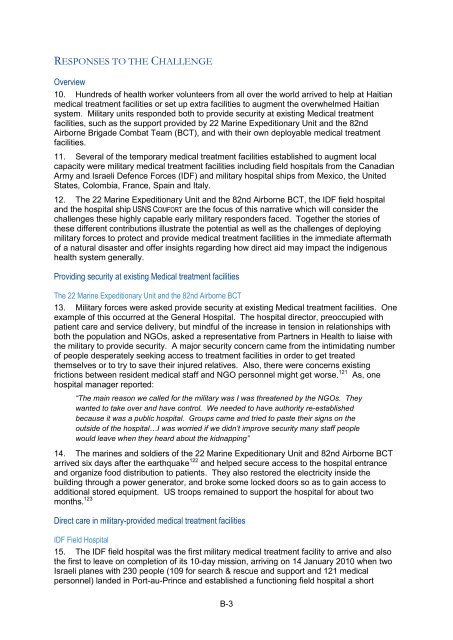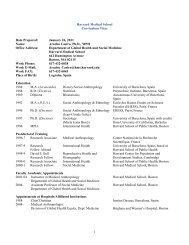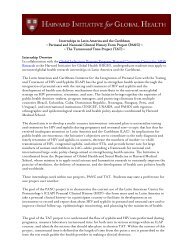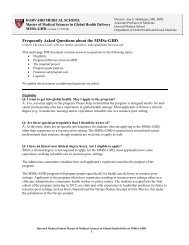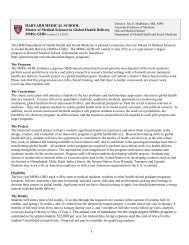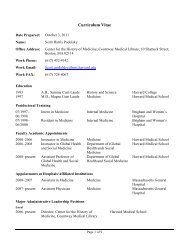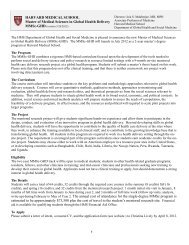Haiti Case Study - The Department of Global Health and Social ...
Haiti Case Study - The Department of Global Health and Social ...
Haiti Case Study - The Department of Global Health and Social ...
Create successful ePaper yourself
Turn your PDF publications into a flip-book with our unique Google optimized e-Paper software.
RESPONSES TO THE CHALLENGE<br />
Overview<br />
10. Hundreds <strong>of</strong> health worker volunteers from all over the world arrived to help at <strong>Haiti</strong>an<br />
medical treatment facilities or set up extra facilities to augment the overwhelmed <strong>Haiti</strong>an<br />
system. Military units responded both to provide security at existing Medical treatment<br />
facilities, such as the support provided by 22 Marine Expeditionary Unit <strong>and</strong> the 82nd<br />
Airborne Brigade Combat Team (BCT), <strong>and</strong> with their own deployable medical treatment<br />
facilities.<br />
11. Several <strong>of</strong> the temporary medical treatment facilities established to augment local<br />
capacity were military medical treatment facilities including field hospitals from the Canadian<br />
Army <strong>and</strong> Israeli Defence Forces (IDF) <strong>and</strong> military hospital ships from Mexico, the United<br />
States, Colombia, France, Spain <strong>and</strong> Italy.<br />
12. <strong>The</strong> 22 Marine Expeditionary Unit <strong>and</strong> the 82nd Airborne BCT, the IDF field hospital<br />
<strong>and</strong> the hospital ship USNS COMFORT are the focus <strong>of</strong> this narrative which will consider the<br />
challenges these highly capable early military responders faced. Together the stories <strong>of</strong><br />
these different contributions illustrate the potential as well as the challenges <strong>of</strong> deploying<br />
military forces to protect <strong>and</strong> provide medical treatment facilities in the immediate aftermath<br />
<strong>of</strong> a natural disaster <strong>and</strong> <strong>of</strong>fer insights regarding how direct aid may impact the indigenous<br />
health system generally.<br />
Providing security at existing Medical treatment facilities<br />
<strong>The</strong> 22 Marine Expeditionary Unit <strong>and</strong> the 82nd Airborne BCT<br />
13. Military forces were asked provide security at existing Medical treatment facilities. One<br />
example <strong>of</strong> this occurred at the General Hospital. <strong>The</strong> hospital director, preoccupied with<br />
patient care <strong>and</strong> service delivery, but mindful <strong>of</strong> the increase in tension in relationships with<br />
both the population <strong>and</strong> NGOs, asked a representative from Partners in <strong>Health</strong> to liaise with<br />
the military to provide security. A major security concern came from the intimidating number<br />
<strong>of</strong> people desperately seeking access to treatment facilities in order to get treated<br />
themselves or to try to save their injured relatives. Also, there were concerns existing<br />
frictions between resident medical staff <strong>and</strong> NGO personnel might get worse. 121 As, one<br />
hospital manager reported:<br />
“<strong>The</strong> main reason we called for the military was I was threatened by the NGOs. <strong>The</strong>y<br />
wanted to take over <strong>and</strong> have control. We needed to have authority re-established<br />
because it was a public hospital. Groups came <strong>and</strong> tried to paste their signs on the<br />
outside <strong>of</strong> the hospital…I was worried if we didn’t improve security many staff people<br />
would leave when they heard about the kidnapping”<br />
14. <strong>The</strong> marines <strong>and</strong> soldiers <strong>of</strong> the 22 Marine Expeditionary Unit <strong>and</strong> 82nd Airborne BCT<br />
arrived six days after the earthquake 122 <strong>and</strong> helped secure access to the hospital entrance<br />
<strong>and</strong> organize food distribution to patients. <strong>The</strong>y also restored the electricity inside the<br />
building through a power generator, <strong>and</strong> broke some locked doors so as to gain access to<br />
additional stored equipment. US troops remained to support the hospital for about two<br />
months. 123<br />
Direct care in military-provided medical treatment facilities<br />
IDF Field Hospital<br />
15. <strong>The</strong> IDF field hospital was the first military medical treatment facility to arrive <strong>and</strong> also<br />
the first to leave on completion <strong>of</strong> its 10-day mission, arriving on 14 January 2010 when two<br />
Israeli planes with 230 people (109 for search & rescue <strong>and</strong> support <strong>and</strong> 121 medical<br />
personnel) l<strong>and</strong>ed in Port-au-Prince <strong>and</strong> established a functioning field hospital a short<br />
B-3


